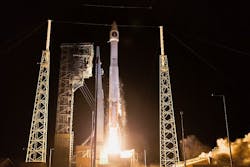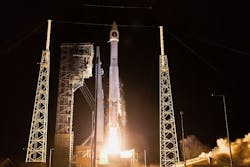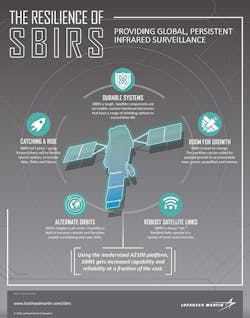Lockheed Martin-Built SBIRS satellite achieves first light, transmits images
SUNNYVALE, Calif. The third Space Based Infrared System (SBIRS) satellite built by Lockheed Martin (NYSE:LMT) in Sunnyvale, California, achieved “first light” and transmitted its first images from its final orbit location – 22,000 miles above the equator – down to Earth.
The satellite was launched on 20 Jan. 2017 aboard a United Launch Alliance (ULA) Atlas V rocket and is the third in a series of Geosynchronous Earth Orbit (GEO) satellites that the U.S. Air Force uses to provide faster and more accurate missile warning data to the nation and its allies. The satellite reached orbit, where it completed deployments of its sun-tracking solar arrays, antenna wing assemblies, and light shade.
“With the satellite successfully on orbit, we are now working to ensure GEO Flight 3 continues the outstanding performance trends demonstrated by its predecessors, including better-than-specified sensor pointing accuracy and the ability to detect dimmer targets than expected,” says David Sheridan, vice president of Lockheed Martin’s Overhead Persistent Infrared systems mission area.
The GEO Flight 3 satellite will provide a wider area of coverage for the U.S. Air Force’s Space Based Infrared System. Once the satellite reached orbit, the team deployed its solar arrays, light shade and antennas, followed by activation of its infrared sensors to begin early orbit testing.
The constellation is operated by the next-generation SBIRS ground station at Buckley Air Force Base, Colorado.
GEO Flight 4, the next satellite in the series, will undergo final assembly, integration and test at Lockheed Martin’s satellite production facility in Sunnyvale prior to its launch planned for later this year.
The team is also working to modernize the fifth and sixth SBIRS satellites under a no-cost contract modification for the U.S. Air Force.
Using a common, modernized A2100 spacecraft bus, the new design allows for a configurable payload module that can incorporate future sensor suites. The design will also save costs on production through a streamlined process, which enables concurrent testing of the satellite bus and payload.
The SBIRS development team is led by the Remote Sensing Systems Directorate at the U.S. Air Force Space and Missile Systems Center, Los Angeles Air Force Base, California. Lockheed Martin Space Systems, Sunnyvale, Calif., is the SBIRS prime contractor, with Northrop Grumman Aerospace Systems, Azusa, Calif., as the payload integrator. The 460th Space Wing, Buckley Air Force Base, Colorado, operates the SBIRS system.
Headquartered in Bethesda, Maryland, Lockheed Martin is a global security and aerospace company that employs approximately 97,000 people worldwide and is principally engaged in the research, design, development, manufacture, integration, and sustainment of advanced technology systems, products and services.
Search the Aerospace & Defense Buyer's Guide
The go-to resource for Intelligent Aerospace technology news & information:
Covering key topics
Across all market segments
Subscribe to the free Intelligent Inbox e-newsletter
Subscribe to receive all the latest aerospace technology news & information, delivered directly to your e-mail inbox twice a week (Tuesdays and Thursdays). Sign upfor your free subscription to the Intelligent Inbox e-newsletter at http://www.intelligent-aerospace.com/subscribe.html.
Connect on social media
Keep pace with aerospace innovation and opportunities via your favorite social media channels. Connect with Intelligent Aerospace on Twitter (@IntelligentAero), LinkedIn,Google+, and Instagram.



